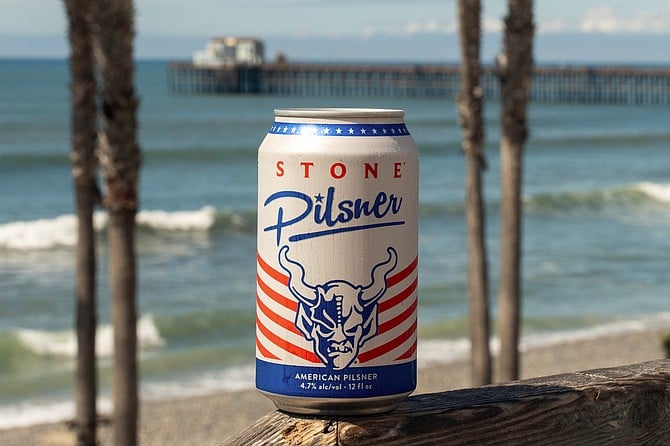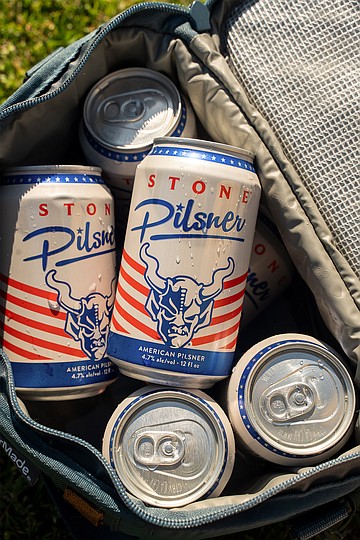 Facebook
Facebook
 X
X
 Instagram
Instagram
 TikTok
TikTok
 Youtube
Youtube

“Brewing a pilsner is no different from brewing a lot of our Stone beers, in particular Stone Buenaveza Salt & Lime Lager,” says Kris Ketcham, Senior Manager of Brewing and Innovation at Stone Liberty Station, explaining how the brewery produced the latest addition to its year-round line: Stone Pilsner. “There are a couple of slight changes here and there, but the main focus is on fermentation with our house lager yeast. Lagers require more yeast and time in the fermentation vessels, which over time allows for maturation, resulting in a crisp and clean quality you would expect in a lager.”
The 4.7% ABV pilsner is yet another example of local breweries feeding the growing public demand for lighter-bodied, smoother brews. Stone Director of Communications and Public Relations Lizzie Younkin points out that, according to NielsenIQ, total craft beer sales in San Diego were down 1% in the last 52 weeks, but craft Pilsners grew by 10%. She continues, “Some reasons why lighter craft beer (e.g., pilsners) may be growing while the overall segment declines include consumers opting for premiumization from their typical domestic light beers, as well as a broader macro trend of moderation.” Younkin cites the aging core demographic of craft beer customers, along with the more health-conscious lifestyle of newly-legal consumers as key contributors to this macro trend.
Of course, more variety is a good thing — and Pilsners are enjoyed throughout the world. As Ketcham points out, “Pilsner is a style of beer that is world renowned and is frequently requested by our guests that travel from all across the globe. While we do have a delicious lager in Stone Buenaveza Salt & Lime Lager, we find that some guests prefer a style of lager with more hop intensity. We’ve brewed a variety of different Pilsner styles over the years, but found we really enjoyed the American Hop profile in our Pilsners.”

The hops used in Stone Pilsner, Cashmere and Vista, impart an orangey breadiness with a herbal aroma to the crisp, crushable beer. The choice of public hops — as opposed to proprietary, patented hops — was important to Stone. Jeremy Moynier, Sernior Manager of Brewing and Innovation explains, “Proprietary hops are awesome, and have gained the most focus over the last few years (and at Stone we use a lot of them). But it’s important to have a balance of both in the supply chain. There has been a lot of work done on the Public Breeding side recently to bolster that program. As part of the Hop Research Council and Hop Quality Group, we support Public Breeding to ensure we have a healthy balance of both public and private. Some of the core Stone Hops (Centennial and Chinook) come out of Public Breeding. Vista has good agronomics and has good sustainable properties. We like to have choices, obviously, when it comes to hops. It’s nice to have an American Pilsner with public American Hops.”
Stone Pilsner is now available throughout the county on tap and in cans.


“Brewing a pilsner is no different from brewing a lot of our Stone beers, in particular Stone Buenaveza Salt & Lime Lager,” says Kris Ketcham, Senior Manager of Brewing and Innovation at Stone Liberty Station, explaining how the brewery produced the latest addition to its year-round line: Stone Pilsner. “There are a couple of slight changes here and there, but the main focus is on fermentation with our house lager yeast. Lagers require more yeast and time in the fermentation vessels, which over time allows for maturation, resulting in a crisp and clean quality you would expect in a lager.”
The 4.7% ABV pilsner is yet another example of local breweries feeding the growing public demand for lighter-bodied, smoother brews. Stone Director of Communications and Public Relations Lizzie Younkin points out that, according to NielsenIQ, total craft beer sales in San Diego were down 1% in the last 52 weeks, but craft Pilsners grew by 10%. She continues, “Some reasons why lighter craft beer (e.g., pilsners) may be growing while the overall segment declines include consumers opting for premiumization from their typical domestic light beers, as well as a broader macro trend of moderation.” Younkin cites the aging core demographic of craft beer customers, along with the more health-conscious lifestyle of newly-legal consumers as key contributors to this macro trend.
Of course, more variety is a good thing — and Pilsners are enjoyed throughout the world. As Ketcham points out, “Pilsner is a style of beer that is world renowned and is frequently requested by our guests that travel from all across the globe. While we do have a delicious lager in Stone Buenaveza Salt & Lime Lager, we find that some guests prefer a style of lager with more hop intensity. We’ve brewed a variety of different Pilsner styles over the years, but found we really enjoyed the American Hop profile in our Pilsners.”

The hops used in Stone Pilsner, Cashmere and Vista, impart an orangey breadiness with a herbal aroma to the crisp, crushable beer. The choice of public hops — as opposed to proprietary, patented hops — was important to Stone. Jeremy Moynier, Sernior Manager of Brewing and Innovation explains, “Proprietary hops are awesome, and have gained the most focus over the last few years (and at Stone we use a lot of them). But it’s important to have a balance of both in the supply chain. There has been a lot of work done on the Public Breeding side recently to bolster that program. As part of the Hop Research Council and Hop Quality Group, we support Public Breeding to ensure we have a healthy balance of both public and private. Some of the core Stone Hops (Centennial and Chinook) come out of Public Breeding. Vista has good agronomics and has good sustainable properties. We like to have choices, obviously, when it comes to hops. It’s nice to have an American Pilsner with public American Hops.”
Stone Pilsner is now available throughout the county on tap and in cans.
Comments